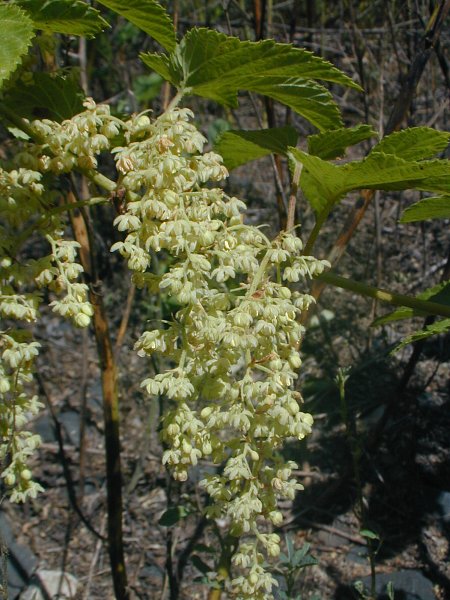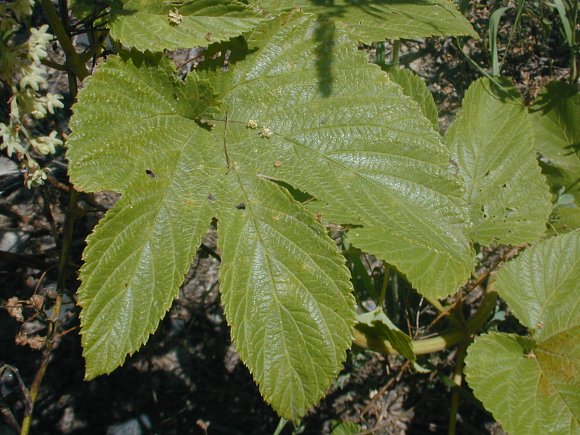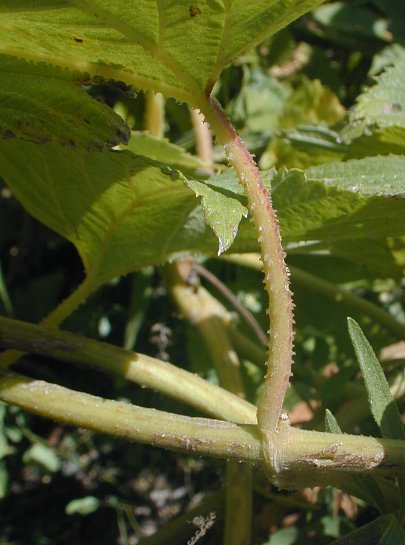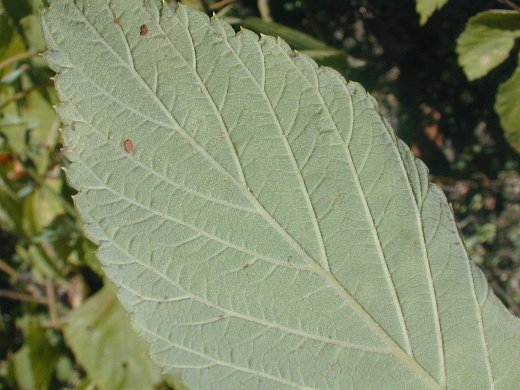Description: This perennial vine is up to 30' long; it dies back to the ground each year. The stems are light green or light tan, stout, and smooth to prickly-bristly. The opposite leaves are up to 6" long and 4" across; smaller leaves are usually oval-cordate in shape, but larger leaves are palmate with 3 lobes (rarely with 5). These leaves have a rough texture and coarse serration along the margins; they are medium green or yellowish green on their upper surfaces, and whitish green below. The long petioles are light green or light tan, stout, and prickly-bristly. At the base of each petiole is a pair of lanceolate stipules. The hairiness or pubescence of the stems and leaves is variable, if it is present at all. Usually, there are small white hairs along the major veins on the leaf undersides; sometimes these veins are also prickly. American Hops is dioecious, with male (staminate) and female (pistillate) plants. The male plants produce drooping panicles of staminate flowers. These panicles are up to 12" long and 6" across; they contain numerous small flowers that are yellowish or whitish green. Each staminate flower has 5 sepals, 5 stamens, and no petals. It has a star-like appearance and spans about ¼" across, hanging downward from a slender pedicel that is often slightly pubescent. The non-sticky pollen is produced in great abundance and it is easily dispersed into the air.

The female plants produce odd-looking cone-shaped spikes of pistillate flowers (aments) from the axils of the leaves. A spike of pistillate flowers is up to 3" long, 2" across, and ovoid in shape; it usually hangs downward from a slender peduncle. The pistillate spike consists of overlapping green bracts that are ovate; there is a pair of pistillate flowers tucked between each adjacent pair of bracts. Each pistillate flower consists of little more than an ovary with a sticky stigma that is long and slender. Both the male and female flowers bloom during the late summer for about 2 weeks. The male flowers quickly turn brown and wither away, while the fruits (or aments) of the female flowers persist longer and gradually turn brown. Each pistillate flower produces a capsule with a single seed that is resinous and aromatic. This vine reproduces by reseeding itself.

Cultivation:
The
preference is partial or full sun, fertile soil, and moist to slightly
dry conditions. This robust vine will also grow in poor soil that is
rocky or gravelly. It can be quite aggressive and appears to have few
problems with disease.
Range & Habitat:
The native American Hops is a common plant that occurs in most areas of
central and northern Illinois. However, it less common or absent from
many areas of southern Illinois (see Distribution
Map). Other varieties of this vine also occur in Eurasia.
American Hops occurs in openings of both upland and floodplain forests,
woodland borders, thickets, and slopes of bluffs. In more developed
areas, it is found along fence rows, vacant lots, areas along
railroads, and miscellaneous waste areas. This plant favors areas that
are more or less disturbed, whether from human activities or natural
causes. It often clambers over surrounding vegetation, including shrubs
and small trees.

Faunal Associations: Pollination is by wind, rather than insects. However, the abundant pollen of the staminate flowers attracts flower flies (Syrphidae) and small bees. The caterpillars of several butterflies feed on hops (Humulus spp.), including Vanessa atalanta (Red Admiral), Polygonia interrogationis (Question Mark), Polygonia comma (Comma), and Strymon melinus (Gray Hairstreak). The caterpillars of the latter species feed on the fruits and developing seeds. The caterpillars of some moths also feed on hops; they include Eudryas grata (Beautiful Wood Nymph), Hydraecia immanis (Hop Vine Borer Moth), Hypena humuli (Hop Looper), and Cnephasia longana (Omnivorous Leaftier). Other insect feeders include Taedia hawleyi (Hop Plant Bug), Phorodon humuli (Hop Aphid), Psylliodes punctulata (Hop Flea Beetle), larvae of Lasioptera humulicaulis (Hop Stem Gall Midge), and the thrips Neohydatothrips beachae. Little information appears to be available about this vine's relationships to vertebrate animals, however it undoubtedly provides protective cover for many species of birds and mammals.

Photographic
Location:
A sunny area along an abandoned railroad in Urbana, Illinois. This vine
also occurred in partially shaded areas at the same locality.
Comments:
American Hops has some resemblance to grapevines (Vitis spp.), but it
is a coarser and more bristly vine that flowers late in the year, while
the latter flowers during the spring. The female fruit of hops is used
to flavor beer and prevent decay during fermentation from bacterial
processes. It is possible that the wind-dispersed pollen may cause
allergic reactions in some people. There are both European and American
varieties of this species, and it is quite possible that they have
interbred in the wild. Consequently, they are often hard to
distinguish. There is a variety of American Hops that has unlobed
leaves. There is an invasive non-native species of hops that occurs in
the wild, Humulus japonicus (Japanese Hops). This
is an annual vine that has leaves with more lobes (5-7) than American
Hops. Furthermore, the lobes of its leaves are more narrow and pointed.